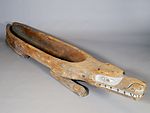łukwalił (Feast Dish)
About this object
History of use
Feast dishes were used primarily to hold food served to guests at important social occasions. Great “house dishes” could hold immense quantities of food. They also held their own names and histories, and were among the most valued privileges passed on through marriage and inheritance.
Cultural context
ceremonial; potlatch; status; privileges
Iconographic meaning
Wolf is often represented in Kwakwaka'wakw sculpture with an elongated and squared snout, and pointed ears.
Physical description
Carved, wooden feast dish in the shape of a crouching wolf with its back hollowed out to make a long, deep bowl. Black and white painted ovoid denotes shoulder joint. The eyes, nose and teeth are carved and painted black and white. The paws are carved and act as support to the bowl. Sides are finely adzed in horizontal lines, while the interior is more boldly hollowed out to form a huge dish. There are two square holes on the head, probably for the attachment of ears. The bright paint appears to have been added later as there are older, very faded, images along the side of the dish.
Materials
Subjects
